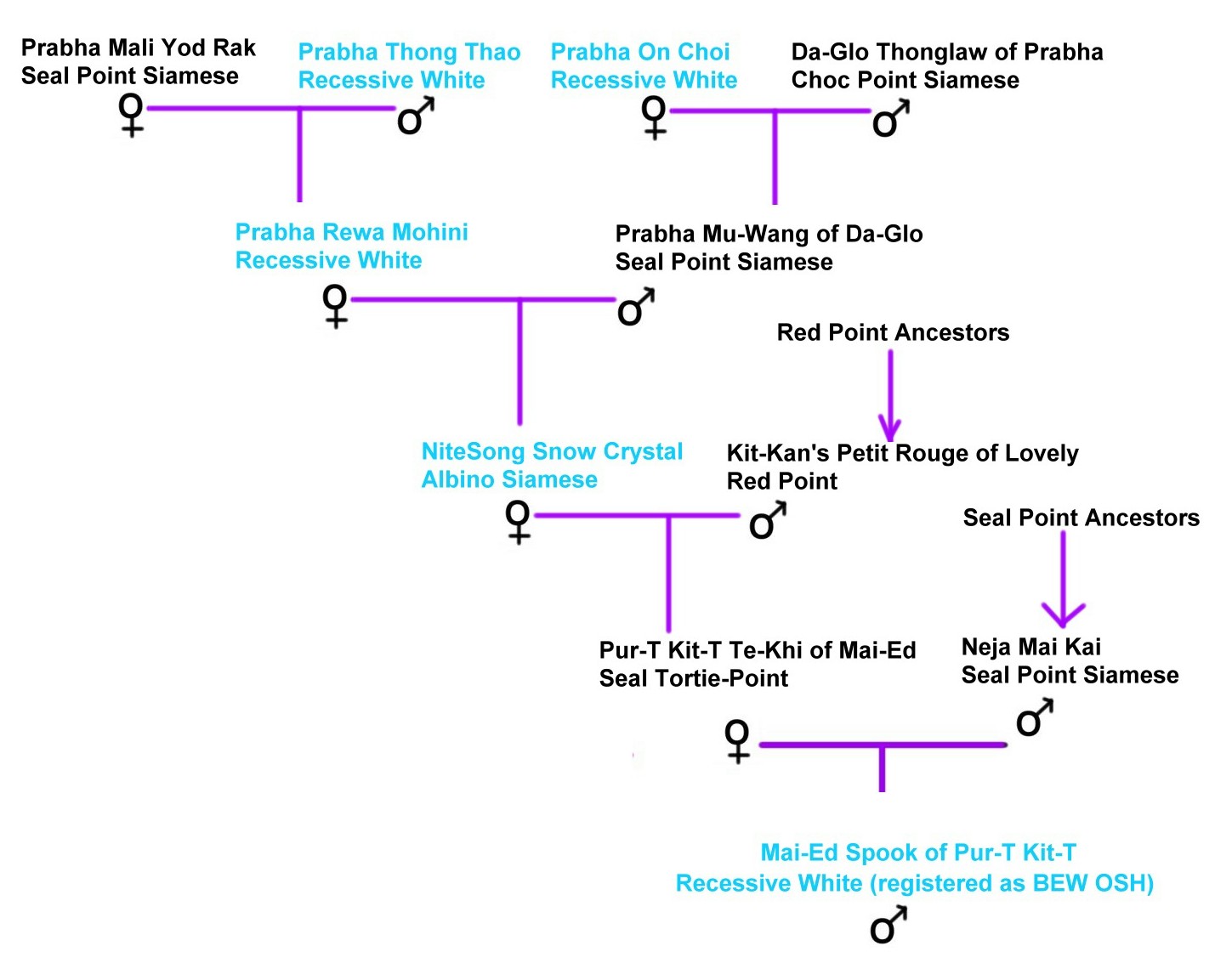
RECESSIVE WHITE / ALBINO IN CATS
Full blue/pink-eyed albino is more often called “Recessive White“ by cat breeders to differentiate it from the temperature dependent albino gene responsible for colour-pointing. The gene which produces Recessive White cats is fully recessive to both Siamese pointing and is fully recessive to full colour - i.e. Siamese or Orientals carrying the gene look exactly the same as Siamese or Orientals that don't carry it. Having said that, Seal point Siamese carrying Recessive White in Australia were noted to be much paler than non-carrier Seal Points. In the USA, they called "Spoiled Seal Points" as the colour was lighter than seal, but not as light as chocolate. Some American breeders selected for that intermediate colour.
ORIGIN OF RECESSIVE WHITE IN THE USA
Recessive White originated in the USA and is still present in some lines of Siamese and Oriental (Shorthair and Longhair).
In an article published in the Cat Gazette in 1935, Dr Clyde E Keeler of the Harvard Medical School predicted the appearance of several new varieties of Siamese: White face Siamese, Chinese White Siamese, Piebald Siamese, Red Point Siamese and the Siamese-Persian.
Feline geneticist Don Shaw looked into the Albino Siamese in the 1970s. He found that many were misidentified Foreign Whites, but some had pinkish-blue eyes indicating true albinism. A mutation for "true albinism" had been reported when a Chocolate Point female was bred to her Chocolate Point son. In fact most of the early Albino Siamese were produced from the same inbred Chocolate Point line. This suggested that the mother and son had both carried the Recessive White gene. However, there wasn't a lot of breed data available for analysis.
Shaw tried to explain the effect in terms of known genes rather than a new mutation. He had noticed that early registrations of Albino Siamese mentioned "Chinese Whites". Chinese Whites were blue-eyed white cats of Asian origin; their colour was apparently due to being homozygous for the white spotting gene. One such Chinese White had been introduced into the Chocolate Point Siamese line. Shaw suggested that the Chinese White may also have carried the recessive gene for true albinism. That would mean Recessive White had been introduced from outside rather than being a mutation within the Siamese breed.
Shaw also noted that Chocolate Point and Lilac Point Siamese sometimes had a pink glow to their otherwise blue eyes; this wasn't found in Seal Points or Blue Points. This caused him to suggest that Albino Siamese were blue-eyed whites caused by a double dose of the imported white spotting gene plus a double dose of the pinkish eye shade due to being homozygous Chocolate Point Siamese (which would be masked by the white spotting) i.e. Albino Siamese might not be true albinos, but might be albino mimics.
He didn't discount the possibility of a new gene emerging, but he suggested another scenario involving genes that were already understood i.e. two possibilities: true genetic albinos or albino mimics due to a combination of genes. Shaw was hampered by a lack of breeding data that might have proven the presence of a Recessive White (true albino) gene. Since Shaw's investigation, albinism has since been recorded in the wild in the Asian Leopard Cat and also in the Bengal derived from Leopard Cat hybrids.

“A New Color Of Siamese- Purebred, Too!“ by Ann Manley, published in CATS Magazine, October 1961.
The United Cat Federation, at its annual meeting in May, accorded championship status in the Siamese breed to the albino Siamese which have been registered in the UCF stud book for several years. The accompanying picture of Anart's Snow Prince Felix, albino Siamese male owned by Mr. and Mrs. A. G. Holmes of Fontana, California, demonstrates the appeal of this beautiful color of cat. The Albino Siamese seem to have better type than their normal colored parents. They have no color at all—they are a white which is not chalky and dull, but their coats have a true Siamese sheen and are short and close- lying. The standard adopted varies from the previously recognized colors only in color and eye color. The eye color is not the pink of white rabbits because the blue of the blood vessels and/or muscles shows through to some extent.
These cats trace back to Babi Kiti, a CFA registered cat, who appeared in an article in CATS Magazine, September 1948, with a picture to illustrate, as dam of a litter of four kittens, two Seal Points and two Albinos. At this point, there are two separate strains of the Albino Siamese registered in UCF, each tracing back to Babi Kiti but with the other ancestors quite different. In one case the strain traces to Babi Kiti through her daughter Dixon's Ko Ko and, in the other, through her son, Carnefax Choong Chee. The Albinos seem to be as healthy as their colored counterparts, through litters of normal size and number of sturdy kits.
The Albino gene fits the expected pattern —it is recessive to all other Siamese colors and therefore recessive to all other breeds and colors of cat. Two Albinos bred together produce NOTHING but Albino kits. At this point there have been Seals, Blues and Chocolates which carry the color but it is reasonable to assume that there have been or will be Frosts carrying it as well. Unfortunately the ancestry is registered variously in ACA and CFA but the pedigrees have reached the point that they meet UCF Stud Book requirements in the Albino registrations. The CFA FR numbers which occur in the pedigrees are due in most cases to registrations immediately preceding the CFA registrations. The Albinos have been exhibited in AOC and UCF shows in the Los Angeles area for several years. Look for them in larger numbers now they are to be in championship classes.
In Michigan in the mid 1970s, Betty Pursglove was breeding White Orientals (Foreign Whites), an emerging variety in the American cat fancy. White Orientals should have the Dominant White gene, but some of Pursglove's whites were actually Albino Siamese. The best known albino was Mai-Ed Spook of Pur-T Kit-T who appears as blue-eyed White Oriental Shorthair on some pedigrees. Mai-Ed Spook was from Neja Mai Kai (Seal Point Siamese) and Pur-T Kit-T Te-Khi of Mai-Ed (Seal Tortie Point Siamese/Colorpoint Shorthair). Because Spook and his offspring bred as dominant whites, some of his white ancestors must have been dominant white but mis-identified as albino! Albino still exists in the American Colorpoint Shorthair and Colorpoint Longhair and occasionally resurfaces.
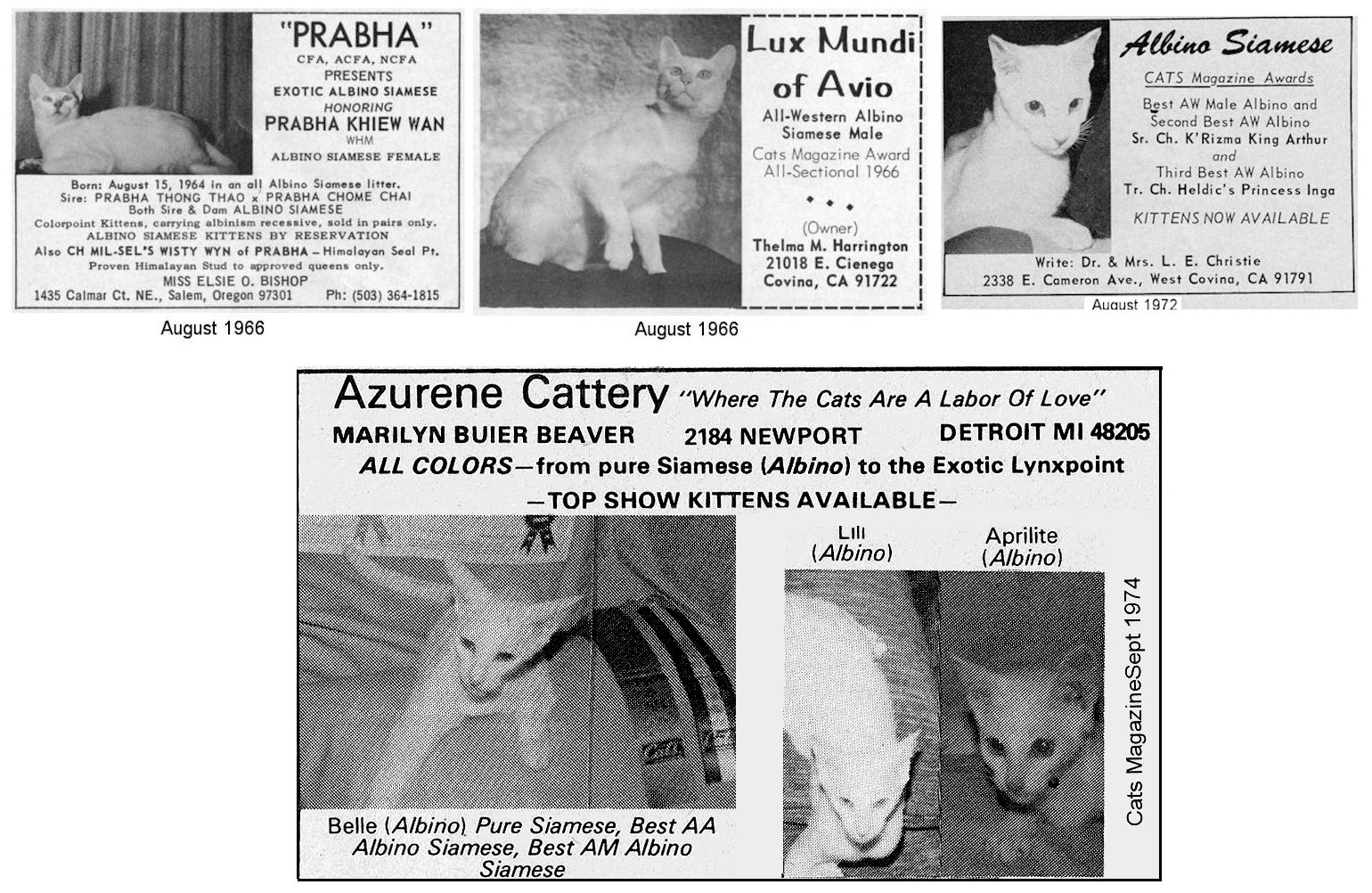
During the 1970s, Cats Magazine in the USA periodically carried letters about the albino Siamese, mostly in their genetics question and answer section “What's My Line“ where queries were answered by Don Shaw.
Cats Magazine, June 1972 - Q. Please explain to me, genetically, why I get all Albinos in my litters from breeding an Albino Siamese to her son who is a "sort of“ Chocolate. Enclosed are the pedigree of the Albino and the Chocolate. Maybe I do not have enough data to make this statement, but 1 have had two litters (six and eight kittens) from this mating, all Albino kittens. The son has been entered in a show and judged as a Chocolate, although he is, perhaps, what Jane Martinke would call a "neither-nor“ between Chocolate and Seal. His point coloring is dark brown; pads are pinkish chocolate.
A. If this is unquestionably the sire of all fourteen kittens - since by your description and the pedigree information supplied, he is a heterozygote for the Siamese allele and the Albino allele (c/c s) - one would have expected one-half Albino to one-half Siamese-marked kittens. The probability of fourteen out of fourteen being Albino is (0.5)14, or one chance in 32,768, if the alleles "c" and "cs" are segregating normally and are both viable. As you can easily see, this is not a very probable answer, if you are sure of the data, then the most probable answer is that the allele "cs" is defective and either is not segregating to half the sperm cells, or the sperm cells carrying this allele are inviable.
On the "neither-nor“ status of the "Chocolate" male, I suggest that genetically he is really a Sealpoint both from your description and his pedigree. Seals which are heterozygous for albinism generally develop pigment more slowly, and frequently mimic a Chocolate until they are two or more years of age, maybe even forever, particularly if blue (maltese) is also heterozygous which is obligated in this pedigree since the boy in question has a Frost/Lilac) point parent. You breeders who are working with Albinos will continue to have problems with "neither-nors.“ Heterozygous Albino/Siamese Bluepoints tend to look like Frosts ( Lilacs ). This will add greatly to the already existing problem of spoiled Seals, Chocolates, Blues and Lilacs (Frosts) - to say nothing of the paling effect on the Redpoints who are all too frequently really Creampoints. – Don Shaw
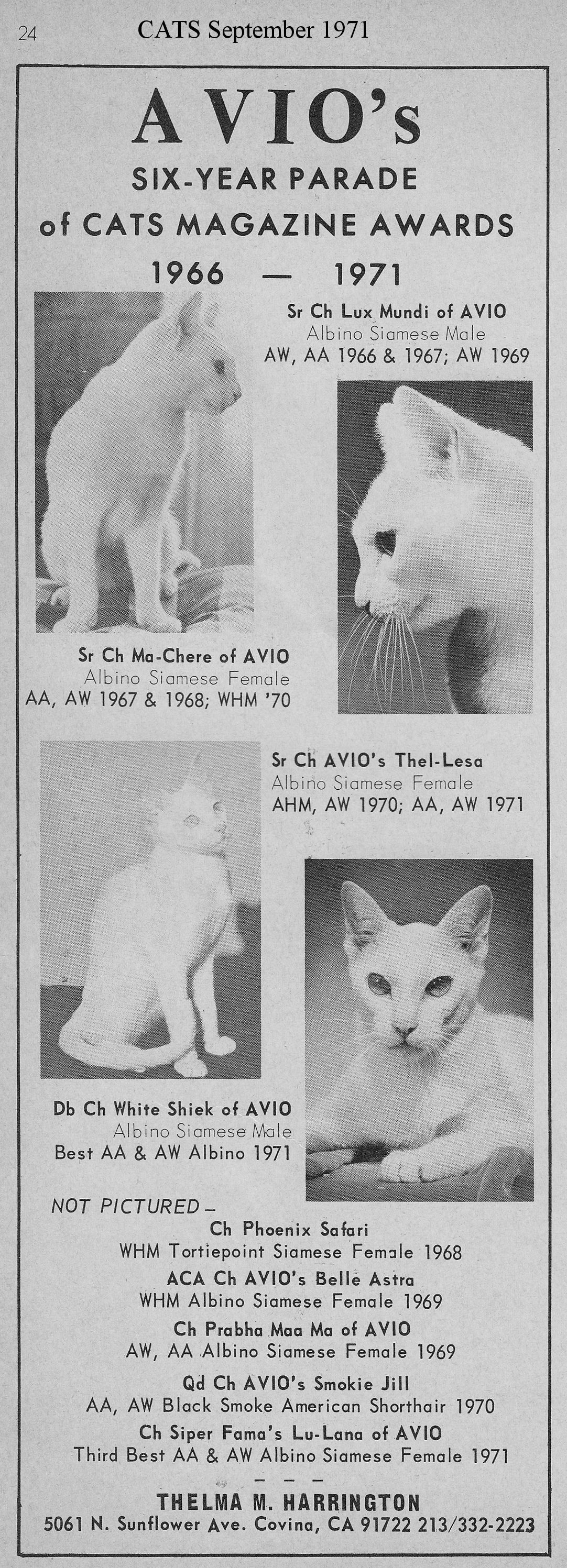
Q. I am interested in becoming a breeder of Albino Siamese (presently I have a Bluepoint and a Frostpoint) [. . .] are there any current [Albino] title holders? Are Albino Siamese accepted at shows?
A. By the term "title holders," I assume you mean have Albinos been shown and garnered championships, All-Americans, etc. Yes, Albinos are recognized for championship competition in the National Cat Fanciers Association as Albino Siamese. Crown Cat Fanciers Federation accepted them as Albino Foreign Shorthairs, but I understand that this association has subsequently withdrawn recognition of this breed for championship showing. To my knowledge, none of the other seven associations presently recognize the Albino for championship. – Don Shaw
Cats Magazine October 1972 - Q. Is there any way that two Albino (at least in appearance) Siamese could, when bred together, produce anything but Albino offspring?
A. True albinism in cats results from a recessive allele in a series of multiple allelic genic factors. See A to Z series, Parts III and IV, CATS, November and December, 1970. Therefore, an Albino would be expected to be homozygous recessive (c/c). The breeding between two such (c/c) homozygotes would be expected to produce only homozygous recessive (c/c) offspring. If the c-allele is all the parents have to offer, then two c-alleles are all the progeny can be expected to receive. Note: There is some evidence from present Albino cat breedings which indicates that the white and white-spotting genic systems may be involved. A cat which is in reality a Blue-Eyed White genetically and which is also homozygous for chocolate dilution (b/b) could conceivably appear to be an Albino. Chocolate dilution is known to result in a rosy pink glow to the otherwise blue eyes, so this genotype would result in an all-white cat whose eyes are pinkish blue. The phenotype now accepted as Albino. If there are albino mimics (albino phenocopies) and one of these is bred to a true Albino, or if two such pseudo-albinos were bred together; then you could obtain pigmented progeny. We are now researching this problem and hope to have more conclusive data to report in the A to Z series in the next few months. – Don Shaw
Cats Magazine, March 1974 - I object very much to a statement made by John Lazar in the January Fanciers' Forum. He states that no Siamese cat has been in the All-Americans for more than two years. This is not true. My Albino Siamese, Nitesong Snow Crystal of Purr-Ti Kit-Ti, has been All-American for five years - and she'll probably make it again this year. - Betty Pursglove (letters)
Cats Magazine, May 1975 (letters) - I am crusading for Albino Siamese. England has long had a show standard for Albino Siamese. Why should America be so far behind? I got interested in the Albino when I took one as a stud fee. That cat was perfect as to the Siamese confirmation and eye color. In your magazine, I find few references to the Albino, and even fewer breeders represented. I've read CATS since 1946 and have been a Siamese breeder almost that long. This is an appeal to anyone breeding registered Albino Siamese to write to me. The time is ripe - or over-ripe - to introduce this lovely color phase to the public. My Albinos are ethereally beautiful and have wonderful dispositions. Please, I'd like to hear from other people working with these cats. - Mrs. Doris E. Fredell, Kalihi Cattery (letters)
In the Feb 2006 Newsletter of the Cat Fanciers Association Gulf Shore Region, the Breed Committee passed a 75:21 vote in favour of ending the registration of Albino Siamese. The actual number of Albino Siamese in existence in the USA is complicated by cat owners, and novice breeders, who refer to their Dominant White Oriental cats as Albinos.
RECESSIVE WHITE IN THE UK
CAT RESEARCH (Hartlepool Northern Daily Mail, 10th April 1931). Coffee-Coloured & Pink-Eyed Strains. White cats with pink eyes, and Cats the colour of ground coffee are the latest ambition of the zoological department of the University of Liverpool. One cat of each of these new types in the possession of the University, and elaborate breeding experiments are being undertaken in an endeavour to establish permanent strains. The white cat appeared in a strain of Siamese, and first attracted attention at the Paris show of last year. Its distinguishing feature is the pink colour of the eyes, for although albino rabbits are exceedingly common, albino cats have been hitherto unknown. The second cat was shown by the late Mr. H. C. Brooke as a “self-red“ at the Crystal Palace. But it is pointed out by the workers at Liverpool that its colour is entirely different from anything found on a normal “red“ cat; in fact, that is a true dark brown without markings. Nothing is known of the origin of this cat, nor of how its colour can have been transmitted.
Despite the 1931 report and the breeding experiments in Liverpool, European lines carrying Recessive White appear to have originated in the US, with the Recessive White Anart's Miiko, imported into the UK by Maureen Silson, and entered the Abyssinian, Siamese and Oriental gene pool. Anart's Miiko was used in Maureen Silson's cinnamon breeding programmes in the 1960s.
Silson (Southview cattery) had been breeding Tabby, Red and Tortie Point Siamese. It was known that in Guinea Pigs, the combination of a red gene and the Colourpointing gene produced an animal that was albino in appearance. It was suggested that it might work the same way in cats. It was already known that the sex-linked red gene combined with the Colourpointing gene produced red-point Siamese. However, there was a non-sex-linked red found in Abyssinian cats i.e. Sorrel. Silson set out to combine the sorrel gene and colourpointing gene to see if this would produce albino-looking cats.
Pam Evely (Kemow) mated Annelida Fair Maid (Seal Point Siamese female) to Tranby Red Tutankhame (Sorrel Abyssinian male) and provided offspring to Silson. Kernow Gerza was a brown agouti male (Chocolate ticked) intermediate in type between Siamese and Abyssinian. When mated to his own sister, Kernow Koptos (black agouti) it resulted in Cinnamon Oriental Shorthairs. Silson mated Cinnamons and Cinnamon-carriers to Siamese and obtained Cinnamon-pointed Siamese rather than white cats.
Silson had imported Anarts Miiko, from the USA. Anart's Miiko was registered with the GCCF as "Siamese, Any Other Colour" and in those pre-internet days it would be some time before it was common knowledge that she had been registered in the USA as an Albino Siamese (now known as Recessive White). Anarts Miiko was mated to Kernow Gerza, producing Southview Unacassiopeia (Havana female) whose progeny carried both cinnamon and the unknown, and undesirable, Recessive White into both British and European Siamese and Oriental lines. The gene was only associated in with Southview Siamese and Oriental Shorthair lines and it was a headache for in the early days of cinnamon development.
As cats whose ancestors included Anart's Miiko spread, the GCCF introduced a Registration endorsement on Anart's Miiko's descendants as they were excellent examples of the developing Havana/Oriental breeds. Eventually many of those breed lines were cleared as being free from the Recessive White allele. To “clear“ a line, it was necessary to mate the suspected carrier to a Siamese and to continue to breed from the self-coloured offspring: self coloured kittens were in possession of the Siamese allele, and therefore by definition free from the Recessive White gene.
Once identified and deemed undesirable, Recessive White was probably eliminated in the UK by removing known carriers from breeding programmes, although recessive genes can remain hidden for generations. In the mid 1970s, no Recessive Whites, or cats bred from them, were allowed to be registered with the GCCF. In 1979, they were allowed to be registered on the GCCF Experimental Register, but not shown. Carriers bred from Recessive Whites were registered on the Supplementary Register as “not recommended for breeding“.
Southview cinnamon lines were used in other cinnamon programs, as were Siavana lines; Siavana Charlie Brown, documented in the UK as having sired Recessive White progeny, was exported to Holland though there are no records there of him producing Recessive White progeny there. Maria Falkena used Charlie Brown in her lines, so the Recessive White gene would also have been introduced into Dutch and European lines. It may still lurk in some lines as the cinnamon gene pool is quite small and recessive genes can go unnoticed for generations until two carriers are mated together.

Greer Stothers (2013) provided photos of this albino Oriental Longhair, Pangur. Pangur's eyes look like faded lilac-blue. On close inspection, the pupil is a dull red, while what looks like lilac is just the pale blue refraction of the lens overlaid on a pinkish pupil. This makes Pangur very photo-sensitive. Pangur's parents are half-siblings with the same father - the female (Catajam Calla Lilly-of-Chii-Tah, a blue-eyed white carrying albino) carried albino, she passed it to her son (Chii-Tah Powder), then mated with her son and produced an albino kitten (Chii-tah Pangur Ban).
The Southview Line
The best documented Recessive White Oriental cats were those owned and bred by Julia May who owned a number of Anart Miiko's (Recessive White female) descendants in Britain.
Southview Duaha (b 1971) was a daughter of Anart's Miiko and joined May for a while in 1974. Southview Cia (Flossie ?-1985) was a great-granddaughter of Anart's Miiko and joined May in 1974. Southview Cia was mated to Southview Trapper, resulting in a litter of Havanas. Because there was a question about the health and viability of a near-albino cat, the GCCF initially refused to register any Recessive Whites or their offspring. By the time the GCCF allowed their registration, May had 20 such cats including their various Siamese and Oriental descendants.
Southview Duae (a grandson of Anart's Miiko) was mated to Southview Alice, resulting in Southview Quando. In 1976 Southview Quando (great-grandson of Anart's Miiko and half-brother to Southview Cia) sired Recessive White offspring on Phaeon Phantamov Theopra (a daughter of Southview Duaha i.e. grand-daughter of Anart's Miiko): Phaeon Junket, Phaeon Pinky, Phaeon Perky and 'Fuchsia'. Far from being unhealthy or non-viable, Quando lived to the age of 17 after being neutered. Southview Duae also produced Kimhay Fudge who produced Siavana Charlie Brown, who introduced the Recessive White gene into European lines.
Palantir Alabaster was a kitten from Southview Cia's fourth litter, this time sired by Southview Quando. Alabaster's grandsire on both sides was Southview Duae. Alabaster's first litter (4 kittens) did not survive, but a repeat mating resulted in seven healthy kittens.
In 1978 Phaeon Junket (later renamed “Sooty“!) was mated to Southview Cia, resulting in Palantir Yoghurt, Palantir Curds, Palantir Whey, Palantir Starsky and Palantir Hutch – all Recessive Whites. Palantir Yoghurt and Palntir Whey produced Palantir Semolina who was also healthy despite coming from a brother-sister mating.
As no-one had done a mating to see if Burmese was completely dominant to Recessive White or not. May mated Southview Cia to Arolan Brown Tiger, a Brown Burmese, resulting in four brown kittens and one chocolate Tonkinese.
Southview Cia's fifth litter was sired by Denka Prince Odarkness ('Dumbo'), a red Devon Rex. One of the offspring, Palantir Tiddles, a Chocolate Tortie Devon Rex Variant, went to live with Denka Prince Odarkness's breeder, Venita Cook, and produced some Devon Rex offspring for her, which means there may be Recessive White lurking n the Devon Rex gene pool.
RECESSIVE WHITE IN EUROPE
In the note below, Havana was the GCCF breed name for the Chestnut (Chocolate) Oriental Shorthair. It is not the same as the American Havana Brown.
1960s US import Anarts Miiko was registered with the GCCF as "Siamese, Any Other Colour" and by the time it was known that she was an Albino Siamese (Recessive White), the gene had entered the Siamese and Oriental gene pool in England and had also been exported to the Netherlands.
Female Anart's Miiko was mated to Kernow Gerza, producing Southview Unacassiopeia (Havana (Choc/Chestnut Oriental) female). Kernow Gerza was sired by Tranby Red Tutankhamen (Sorrel Abyssinian) and his mother was Annelida Fair Lady (Seal Point Siamese).
Southview Unacassiopeia was mother of Southview Duakali (Havana (Choc/Chestnut Oriental) female) who was the mother of Siavana Charlie Brown (Havana (Choc/Chestnut Oriental) male). The father of Siavana Charlie Brown was Kimhay Fudge (Chocolate Point male). Genetically, Siavana Charlie Brown carried csca. “Siavana“ is a portmanteau of “Siamese“ and “Havana“. Siavana Charlie Brown was therefore quite a mixed bag of genes, having some Abyssinian heritage as well as Oriental Cinnamon and Recessive White heritage!
Siavana Charlie Brown went to the Netherlands and was used by Maria Falkena in breeding Cinnamon Orientals there. In the Netherlands, Siavana Charlie Brown sired Muscato Van Mariëndaal (29k = Cinnamon Oriental male?) from a mating to Akelei Van Mariendaal (Choc/Chestnut Oriental Shorthair female). Muscato Van Mariëndaal was an International Champion and his descendants include Havanas (Twinkle Star line) and further down the line, Chocolate Tabby Spotted Orientals.
A bit further down the line in Europe and Recessive White caused a further complication in Cinnamon Point Siamese. A cat called Diana van der Dutch Highlands Farm carried Recessive White which came from Cherry Garden Orpheus who was believed to be a Cinnamon Tabby Point. Despite supposedly being Cinnamon, Orpheus produced only chocolates when bred with cinnamon girls. He also produced a Recessive White son. This indicated that the Recessive White gene may have had a lightening effect on the chocolate colour that caused Orpheus to be misidentified as cinnamon.
ALBINISM FROM OTHER SOURCES
There was also a line of Bengals with Recessive White; the gene could have come from an early outcross cat, or from the Asian Leopard Cat itself as albino Asian Leopard Cats have been reported and also captured from the wild..
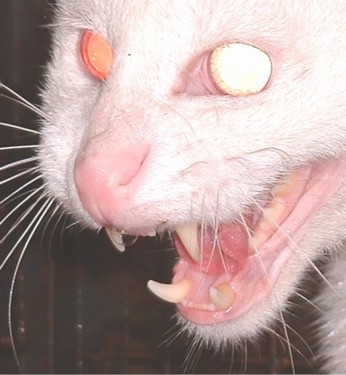
Wild-caught Albino Asian Leopard Cat
Albinism has turned up as a spontaneous mutation in random-bred cats.
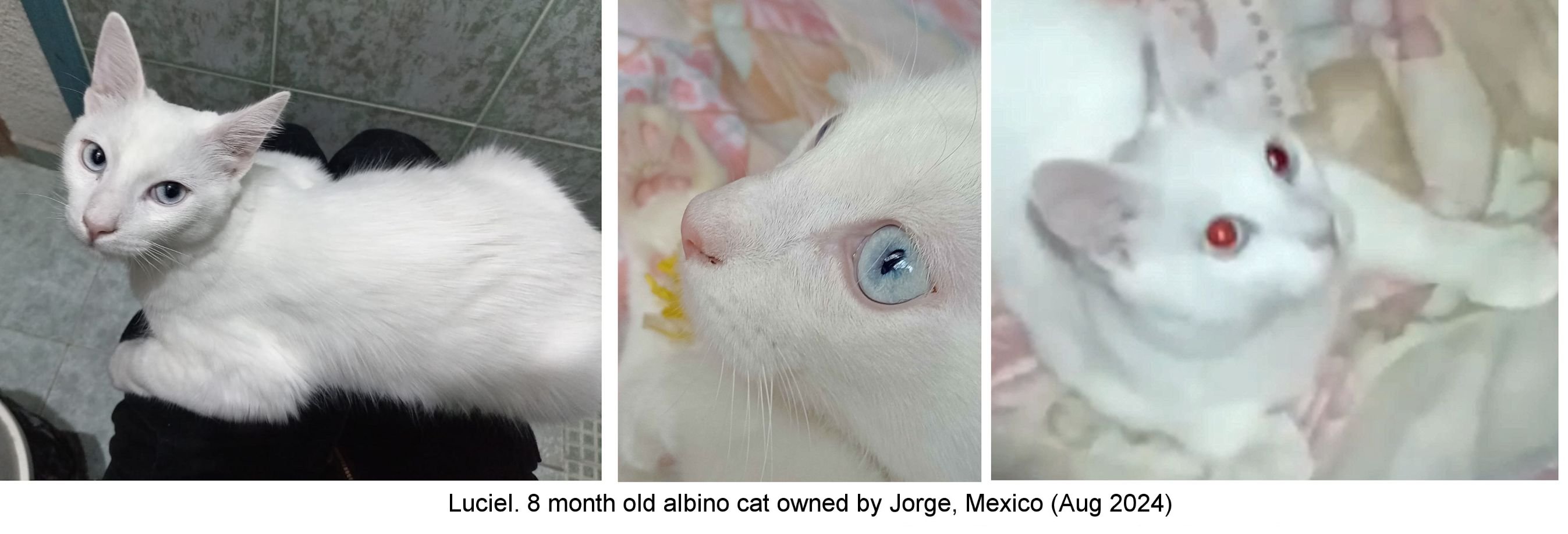
Jorge, from Mexico, sent me photos of his 8 month old cat albino cat Luciel who was adopted randomly. Luciel has very pale blue eyes that reflect red instead of green. He has no spots of any colour, his skin is a light pink everywhere and you can see his blood vessels in his ears in the sun (he is kept out of the sun as much as possible to prevent sunburn).
A breed called the European Albino (a European Shorthair with white coat and pinkish-blue eyes) began development, but seems to have vanished following Companion Animal legislation that overrides cat fancy rules and prohibits the deliberate breeding of genetic defects. Lack of pigmentation and photosensitivity is classed as a defect and therefore cannot be bred in European countries that have signed up to this legislation.